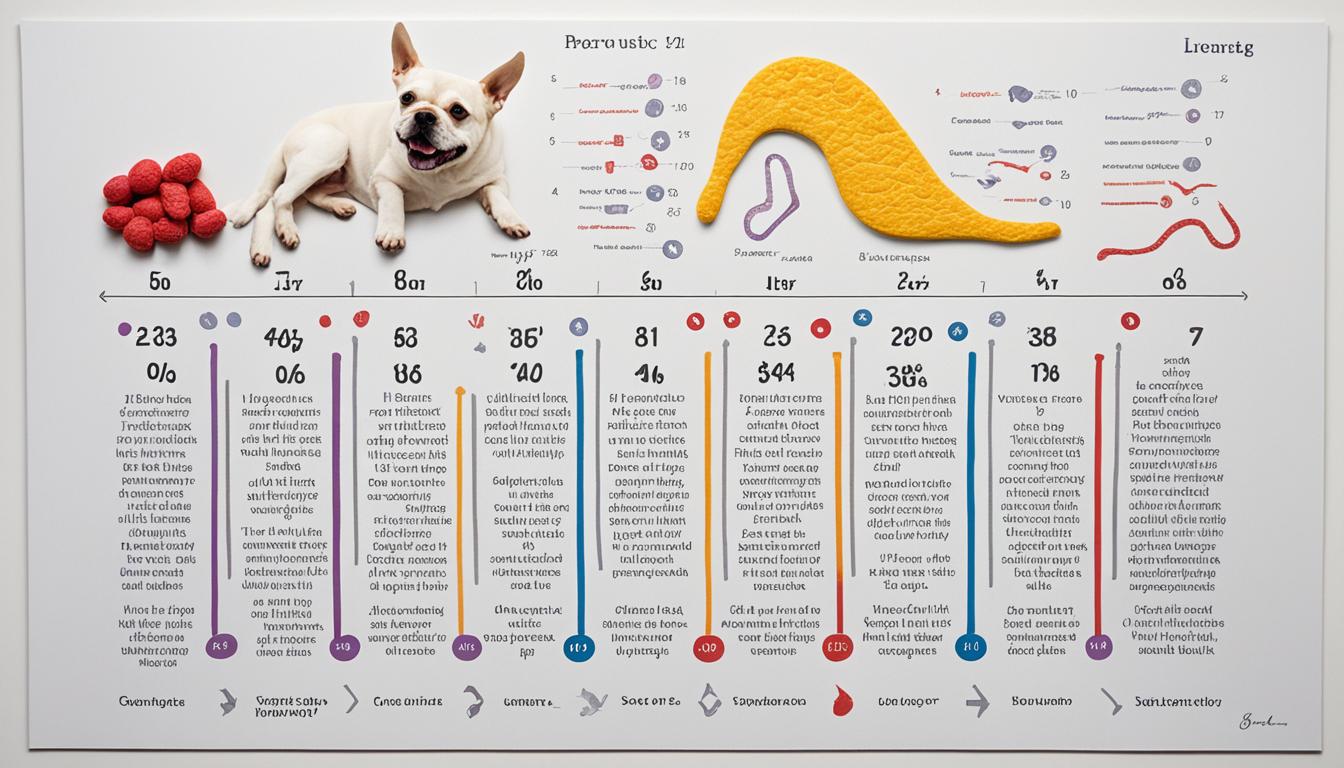Imagine the joy of welcoming a new litter of puppies into your home. The tiny paws, the soft whimpers, and the boundless energy of these young lives bring immeasurable happiness. Yet, behind this joy lies a major responsibility.
Understanding the intricacies of canine reproduction is crucial. This includes not just knowing the number of litters a dog can have. It’s about the health of the mom and her pups. It’s about making smart choices in breeding.
Think about women and how they have kids. A woman can have many children. But it can be hard on her body and heart. It’s the same with dogs. They can have lots of litters, but it’s not good for their health1.
How Many Litters Can a Dog Have in Her Life? Most good breeders suggest around 4-6 litters for a dog. This keeps her healthy and happy12. They also say to let the dog rest when she’s still young. This way, she can enjoy her later years comfortably1.
Some breeders only care about money. They might make dogs have lots of litters in a row. This is bad for the mom and the puppies. It can lead to sickness and small litters2.
Being a good breeder means more than just following rules. It’s about being kind and smart. Talk to vets and learn all you can. This will help you make the best choices for your dog’s health1.
Key Takeaways
- Dogs can have lots of litters, but it’s not good for their health1.
- Good breeders suggest around 4-6 litters for a dog12.
- Having too many litters too quickly is bad for the mom and puppies2.
- Chat with vets to make the right breeding choices1.
- Breeding responsibly keeps the mom dog both physically and emotionally well1.
Introduction to Canine Reproduction
It’s key to know about dog breeding and how dogs become pregnant. This involves many steps and needs thought to keep mom and puppies safe.
Overview of Dog Breeding
Dog breeding happens in steps like getting ready, making puppies, and caring for them. Normally, a dog has about five to six puppies3. But, the amount can change a lot by the dog’s type and age. Great Danes can have about 10 puppies, while a Chihuahua might have just one to three3. Knowing your dog’s needs is very important. This helps in taking good care and knowing what to expect.
Importance of Responsible Breeding
Doing breeding the right way keeps the dogs and the breed strong. Ethical breeders look at if the mom dog is ready, the breed’s special needs, and how breeding affects them long-term. This way, puppies are born healthier and we help keep the dog population in check.
Being a good breeder means being ready for a lot of work. Taking care of many puppies needs a lot of planning and effort. For example, looking after 6 puppies is easier than looking after 12 because it is simpler to handle. Careful and responsible breeding helps make sure dogs are well taken care of, follow good rules, and bring good results for everyone in the long run.
Factors Affecting Litter Size
It’s key to know what affects how many puppies a dog has. Many things change how many puppies are born. This includes the dog’s type, how big it is, and the mother’s health and age. Even the dog’s genes matter.
Dog’s Breed and Size
Big dogs usually have more puppies. For example, Bullmastiffs and Labradors can have 5 to 13 and 5 to 10 puppies4. Yet, smaller dogs like Yorkies and Chihuahuas have 2 to 5 puppies4. For medium dogs like Huskies, they fall in the middle with 4 to 8 puppies5.
Health and Age of the Dam
The health and age of the mother dog matter too. Mothers at their best age, from 2 to 5 years old, have more puppies45. Their first two litters are usually smaller. But, the third and fourth litters are the biggest4. A diet with lots of protein can also help have more puppies4. On the other hand, older dogs over seven have fewer puppies due to less fertility5.
Genetic Factors
Genes are a big part of how many puppies are born. Besides the dog’s breed, other genetic things like color and size can influence litter size by about 15%4. Also, using artificial means can lead to smaller litters than natural ways4.
Knowing about these factors helps you make better breeding plans. This is important for the health of your dogs.
Average Litter Size in Dogs
The number of puppies a dog has can change based on its breed. A dog’s health and how big it is also matter a lot5.
Small Breeds
Smaller dog breeds usually have less puppies. For example, Yorkshires can have 3 to 5 puppies. Pomeranians may have 1 to 45. French Bulldogs, though, average 3 puppies per litter. But, 7 puppies in one litter is their biggest known amount6.
Medium Breeds
Medium-sized dogs like Beagles have a good number of puppies. Beagles may have around 6 in a litter. Yet, they can have up to 13 in their biggest litter6. Labradors, on the other hand, usually have 5 to 8 puppies. Their most in a litter has been 1556. Depending on the size, Poodles vary a lot. Standards get about 7, Miniatures have 5, and Toys get 3. Their biggest litter was 16 puppies6.
Large Breeds
Bigger dog breeds tend to have more puppies. German Shepherds and Golden Retrievers generally get 6 to 9. Some even have 17 at once56. Great Danes and Rottweilers usually have 6 to 8. Yet, Rottweilers had up to 18 once56. For all dogs, being in their prime years of having puppies means they will likely have more. Being healthy helps too5.
Optimal Breeding Practices
Good breeding means knowing a lot about dog health, genes, and how they act. It’s important for breeders to do the right thing for the mother dog and her puppies. Normally, a female dog can have two litters a year, but it’s better for their health to have less. This also helps the puppies stay healthy7.
It’s key to let the dog recover between litters. Waiting after one heat is a must to keep her healthy and lower pregnancy risks2. During the 63-day pregnancy, watching her closely is so important2. Working with vets is vital too. They help keep the dog healthy and spot problems early on.
Stopping a mother dog from breeding at the right time is vital too. A dog should have 4 to 6 litters at most. Big dogs can start having puppies at 2 years old. They should stop by the time they’re 6 to 8. This keeps them healthy and happy. Having only 4 or 5 litters means a better life for the dog2.
Responsible breeding does a lot for the health and quality of the breed. Breeders focus on giving the mother time to rest, watch her health, and know when to stop breeding. These steps help keep their dogs and the breed in good shape.
How Many Litters Can a Dog Have in Her Life?
Dog breeding is important to understand for those in the field. In the U.S., there’s no law limiting how many litters a dog can have. Still, good breeders aim for 4-5 litters at most to keep the dog’s health and morals up1. Even though a dog can birth more than ten litters, caring for the dog comes first, which keeps this number lower1.
United States Regulations
In the U.S., without a set top limit, breeders can choose how many litters to have. Yet, responsible breeders often opt for fewer litters. This helps keep their dogs healthy and happy1. It’s good if buyers look up their area’s dog breeding laws to make sure breeders are being ethical and compliant.
Guidelines of Reputable Breeders
Good breeders always put their dogs’ well-being first. They start breeding on the second or third heat for many dogs, and usually stop at 4-6 litters, even the healthiest moms1.2. This care strategy helps avoid problems like pyometra by not missing heat cycles1. These breeders also work closely with vets to ensure their practices are the best for the dogs.
Ethical Considerations in Dog Breeding
Being a responsible breeder means looking at ethical issues. Good breeders focus on keeping the mother and puppies healthy and safe. We’ll talk about the dangers the mother faces and how it affects puppies when ethics are ignored.
Health Risks for the Dam
Keeping the mother dog healthy is a big deal in breeding right. Having too many litters can cause health problems like eclampsia and a weaker health7. The UKC and the AKC set limits and rules to protect the mother7. But some breeders, only caring about money, don’t follow these rules, putting the mother at risk8.
Impact on Puppies
The way puppies are treated also matters a lot. Good breeders make sure the parents are tested for health problems, lowering the chance of puppies getting sick8. Bad breeders might not do these tests, making it a risk for the puppies8. Puppies need love and learning from early on. Responsible breeders help new dog owners, offering help and advice8.
So, sticking to high ethics in breeding keeps both the mother and her puppies well. Doing it right means more than just meeting legal rules. It’s about caring for our animals and those who will love them as pets.
Legal Guidelines for Dog Breeding
Following canine reproduction regulations is very important. It helps keep breeding dogs safe and obeys the law. The U.S. has no national rule on how many litters a dog can have. But each state and group can set their own rules, which might be strict.
| State | Specific Regulation |
|---|---|
| Arizona | Kennels for fewer than 20 dogs inspected upon complaints; larger facilities need regular inspections and a kennel permit9. |
| California | Breeders must sell, transfer, or give away at least 3 litters or 20 dogs annually and must provide adequate care9. |
| Colorado | Distinguishes between large-scale (100+ dogs/year) and small-scale (up to 99 dogs/year) breeders9. |
| Connecticut | Requires a kennel license for breeding more than 2 litters annually and mandates strict facility standards9. |
| Delaware | Kennels must provide appropriate shelter and care, especially for outdoor dogs9. |
The American Kennel Club (AKC) says dams can have litters when they are 8 to 12 years old. This helps make sure breeding is done right7. But the United Kennel Club (UKC) says a dam should only have 4 to 5 litters. This is to keep the dogs healthy1. States like Arizona and Connecticut have their own rules. They check that places where dogs are bred are good. They make sure dogs are well-fed, happy, and healthy9.
Not following these breeding laws can have big consequences. For example, in California, breaking the rules can lead to a fine of up to $1,0009. In Arizona, not getting a permit for your kennel in time is a crime9.
Keeping up with canine reproduction regulations is for the dogs’ benefit. It is also the right thing to do when breeding dogs dog pregnancy.
Health Risks of Excessive Breeding
It’s key for breeders to know the risks of too much breeding. Overdoing it can make mom dogs very sick. They might get hypocalcaemia, mastitis, or infections in their uterus10. If they don’t get enough time to rest between litters, they could face even worse issues. This could include eclampsia and a big drop in their overall health7. It’s best not to let a dog have more than four to six litters in her life. This helps keep them healthy7.
Physical Health Concerns
Too much breeding is really tough on mom dogs’ bodies. Having puppies over and over, or too quickly, can be very dangerous7. This might lead to problems like hip dysplasia, trouble breathing, and feeling very tired10. To keep dogs safe, breeders should talk to vets. They should also look after the mom dog’s health first1.
Emotional Health of the Dam
Overbreeding also hurts moms emotionally. They can get very stressed and anxious from having lots of puppies10. It’s important to breed in line with their natural cycle, which is usually once a year10. Taking care of mom dogs’ emotions is just as important as their physical health. This is the right way to breed dogs – one that makes sure they’re treated well and have good lives.
FAQ
How many litters can a dog have in her life?
What are the key factors that influence the size of a dog’s litter?
What is the average litter size for various dog breeds?
What are some best practices for breeding dogs?
Are there regulations on dog breeding in the United States?
Why is responsible breeding important?
What health risks are associated with breeding dogs excessively?
What are the ethical considerations in dog breeding?
What legal guidelines should breeders follow?
How do health and age of the dam affect litter size?
Source Links
- https://www.jennaleedoodles.com/post/how-many-litters-can-a-dog-legally-have-the-important-ethics-of-breeding
- https://www.buntypetproducts.co.uk/blogs/dogs/how-many-litters-can-a-dog-have
- https://dremmanuelfontaine.com/2023/11/07/the-science-of-canine-litter-size/comment-page-1/
- https://www.ovrs.com/blog/litter-size/
- https://basepaws.com/dog-insider/how-many-puppies-can-a-dog-have-understanding-dog-litter-sizes
- https://www.akc.org/expert-advice/dog-breeding/average-litter-size/
- https://basepaws.com/dog-insider/how-many-litters-can-a-dog-have
- https://honestdogbreeder.com/69-ethical-breeding-the-economyhow-are-they-related-and-unrelated/
- https://www.animallaw.info/topic/table-state-commercial-pet-breeders-laws
- https://animalemergencyservice.com.au/blog/overbreeding-a-major-animal-welfare-issue/











